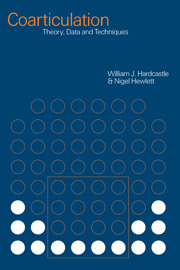Book contents
- Frontmatter
- Contents
- List of figures
- List of tables
- List of contributors
- Acknowledgments
- Introduction
- Part I Theories and models
- Part II Research results: components of the motor system for speech
- 3 Velopharyngeal coarticulation
- 4 Lingual coarticulation
- 5 Laryngeal coarticulation
- 6 Labial coarticulation
- 7 Lip and jaw coarticulation
- Part III Wider perspectives
- Part IV Instrumental techniques
- References
- Index
5 - Laryngeal coarticulation
Published online by Cambridge University Press: 22 September 2009
- Frontmatter
- Contents
- List of figures
- List of tables
- List of contributors
- Acknowledgments
- Introduction
- Part I Theories and models
- Part II Research results: components of the motor system for speech
- 3 Velopharyngeal coarticulation
- 4 Lingual coarticulation
- 5 Laryngeal coarticulation
- 6 Labial coarticulation
- 7 Lip and jaw coarticulation
- Part III Wider perspectives
- Part IV Instrumental techniques
- References
- Index
Summary
Introduction
At one level, voicing coarticulation has frequently been studied as a temporal phenomenon, i.e. as the extension of ± periodicity from one segment to another adjacent one (differently specified phonologically). To take a simple example, consider the devoicing of /l/ in English words such as ‘plead’. There is universal agreement that this can be explained by the influence of the adjacent voiceless /p/. In other words, minimal pairs such as ‘plead’ and ‘bleed’ have not been used to suggest that English has a phonemic contrast between voiced and voiceless laterals. Such combinations of voiceless obstruent + sonorant sequences are probably the consonant clusters that have been most extensively investigated (see below and especially Docherty 1992, for further references), at least in terms of acoustic measurements of the timing of voicing – and they represent one of the two main topics covered in the section on coarticulatory investigations of the devoicing gesture. Of course, there are many other potential sequences of consonants in which the individual members of the sequence differ with respect to voicing specification, and can accordingly influence one another (Westbury 1979; Docherty 1992).
Yet, consideration of even apparently simple coarticulatory phenomena such as the /pl/ case leads inevitably to a widening of the perspective to include questions of interarticulator coordination, in other words the formation and the release of oral constriction for /p/ and /l/, and their temporal relationship to the devoicing gesture.
- Type
- Chapter
- Information
- CoarticulationTheory, Data and Techniques, pp. 105 - 143Publisher: Cambridge University PressPrint publication year: 1999
- 6
- Cited by



